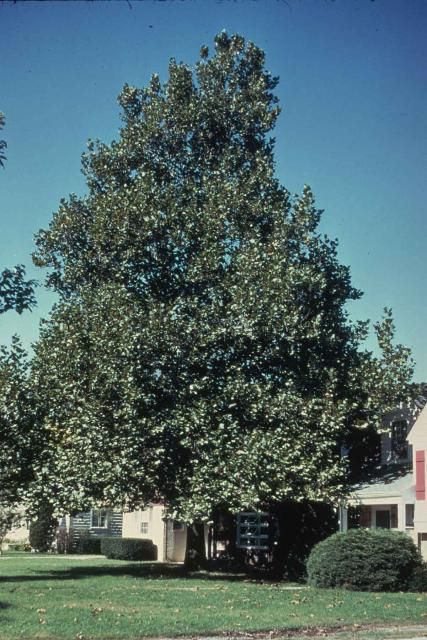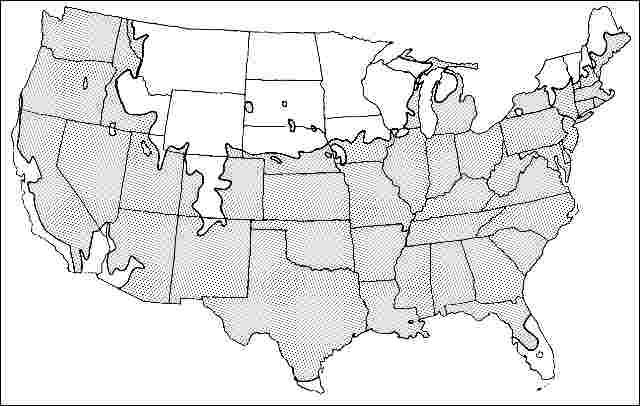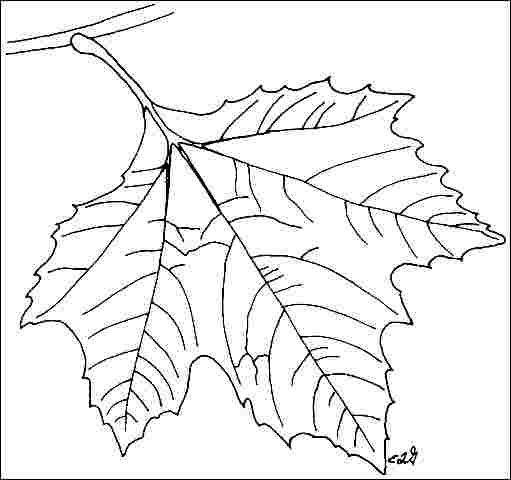Introduction
A large tree resulting in a cross between Platanus orientalis and Platanus occidentalis suitable for use in USDA hardiness zone 4b or warmer. The tree will reach a height of 85 feet and a spread of 70 feet. Pyramidal in youth, it develops a spreading rounded crown with age supported by a few, very large-diameter branches. These branches should be spaced two to four feet apart along the trunk to develop a strong structure. The dominant central leader which typically develops on London Planetree usually assures that the structure of major limbs is desirable with little corrective pruning required other than removing occasionally occurring upright branches with tight crotches. It is also helpful to thin out the many branches which develop early on the central trunk. The bark is patchy and very attractive and may be the plants best ornamental attribute. These patches range from creamy-white to olive-green. Large sections of bark may be shed from the tree as it grows older. This is normal and only needs to be disposed of.

Credit: Ed Gilman
General Information
Scientific name: Platanus x acerifolia
Pronunciation: PLAT-uh-nus x ass-er-ih-FOLE-ee-uh
Common name(s): 'Bloodgood' London Planetree
Family: Platanaceae
USDA hardiness zones: 5A through 9A (Fig. 2)
Origin: not native to North America
Invasive potential: little invasive potential
Uses: specimen; street without sidewalk; shade; parking lot island > 200 sq ft; sidewalk cutout (tree pit); tree lawn > 6 ft wide; urban tolerant; highway median
Availability: not native to North America

Description
Height: 70 to 85 feet
Spread: 50 to 70 feet
Crown uniformity: symmetrical
Crown shape: pyramidal, round, spreading
Crown density: dense
Growth rate: fast
Texture: coarse
Foliage
Leaf arrangement: alternate (Fig. 3)
Leaf type: simple
Leaf margin: lobed, incised
Leaf shape: ovate, star-shaped
Leaf venation: palmate, pinnate
Leaf type and persistence: deciduous
Leaf blade length: 4 to 8 inches, 8 to 12 inches
Leaf color: green
Fall color: yellow
Fall characteristic: not showy

Flower
Flower color: red
Flower characteristics: not showy
Fruit
Fruit shape: round
Fruit length: .5 to 1 inch
Fruit covering: dry or hard
Fruit color: brown
Fruit characteristics: does not attract wildlife; showy; fruit/leaves a litter problem
Trunk and Branches
Trunk/bark/branches: branches droop; showy; typically one trunk; thorns
Pruning requirement: little required
Breakage: resistant
Current year twig color: brown
Current year twig thickness: medium
Wood specific gravity: unknown
Culture
Light requirement: full sun
Soil tolerances: clay; sand; loam; alkaline; acidic; extended flooding; well-drained
Drought tolerance: high
Aerosol salt tolerance: moderate
Other
Roots: can form large surface roots
Winter interest: yes
Outstanding tree: yes
Ozone sensitivity: sensitive
Verticillium wilt susceptibility: resistant
Pest resistance: sensitive to pests/diseases
Use and Management
The plant tolerates dry soil (but scorches in dry weather) and city conditions well, adapts to most soils including alkaline and is more resistant (not immune) to the anthracnose that afflicts Platanus occidentalis . However, it is susceptible to canker stain, a disease which has caused its demise in some areas, and is often seen infested with lace bugs which will not kill the tree but causes premature defoliation in late summer. It is also reported to be susceptible to ozone pollution injury in laboratory tests at levels often present during the summer, but damage from air pollution in the landscapes appears minimal. Some people object to the large leaves which often begin falling from the tree in late summer.
Some horticulturists consider this a messy tree due to early leaf drop from drought, bark shedding, and lace bugs. Leaves blow around in the wind during the fall and decompose slowly in the landscape creating a distinctive "crunch" underfoot. Leaves make great compost in a compost pile.
Some tree managers limit use as a street tree due to its large size, susceptibility to canker stain, bacterial leaf scorch, and lace bug injury. But it is a good durable tree for many areas where soil is poor and compacted. Also somewhat tolerant of coastal conditions, and well-adapted to areas with poor drainage. But it may be best saved for moist sites with plenty of room for root and crown expansion.
The National Arboretum in 1984 released two Platanus occidentalis x Platanus orientalis which could prove to be superior to the parents: Platanus x acerifolia `Columbia' - upright, orange-grey bark, five-lobed leaves; Platanus x acerifolia `Liberty' - upright pyramid, five-lobed leaves, reportedly more resistant to powdery mildew and anthracnose, though not immune.
Pests
Aphids will suck the sap from Planetree leaves. Heavy infestations deposit honeydew on lower leaves and objects beneath the tree, such as cars and sidewalks.
Sycamore lace bugs feed on the undersides of the leaves causing a stippled appearance and premature defoliation in late summer. The insects leave black flecks on the lower leaf surface. Neither aphids nor lace bugs will kill the tree.
Diseases
Some fungi cause leaf spots.
Anthracnose: `Bloodgood' has been shown to be resistant to anthracnose, but it is not immune. Anthracnose causes early symptoms on young leaves resembling frost injury. When the leaves are almost fully grown light brown areas appear along the veins. Later the infected leaves fall off and trees may be nearly completely defoliated in spring or early summer. The disease can cause twig and branch cankers and a witches-broom appearance at the end of the branches. The trees send out a second crop of leaves but repeated attacks can lower tree vigor. Use a properly labeled fungicide to help control the disease. Fertilization helps trees withstand repeated defoliation.
Canker stain is very serious on London Planetree and can kill the tree.
Bacterial leaf scorch can devastate London Planetree.